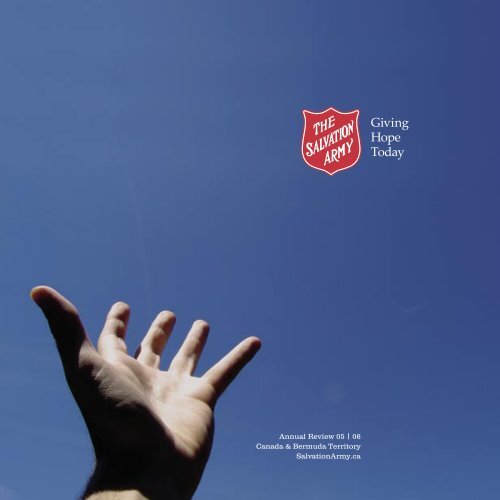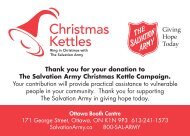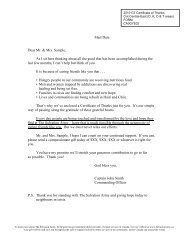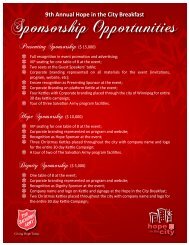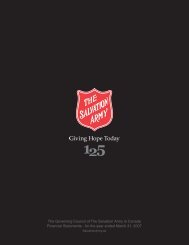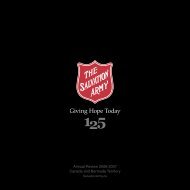Annual Review 05 | 06 Canada & Bermuda Territory SalvationArmy.ca
Annual Review - The Salvation Army in Canada
Annual Review - The Salvation Army in Canada
Create successful ePaper yourself
Turn your PDF publications into a flip-book with our unique Google optimized e-Paper software.
<strong>Annual</strong> <strong>Review</strong> <strong>05</strong> | <strong>06</strong><br />
<strong>Canada</strong> & <strong>Bermuda</strong> <strong>Territory</strong><br />
<strong>SalvationArmy</strong>.<strong>ca</strong><br />
Giving Hope Today 3
Over 1.5 million people were helped by The Salvation Army in <strong>Canada</strong> and <strong>Bermuda</strong> last year.<br />
Some of the services offered include:<br />
Addictions, Rehabilitation & Shelter<br />
5,000 shelter beds provided for the homeless each night<br />
10,000 people with addictions received assistance<br />
1,100 people successfully completed addiction &<br />
rehabilitation programs<br />
2.5 million meals served<br />
Community Churches<br />
350 community churches<br />
Community & Family Services<br />
900,000 family members provided with food, clothing or<br />
practi<strong>ca</strong>l assistance<br />
8,500 children went to Salvation Army <strong>ca</strong>mps<br />
Emergency Disaster Services<br />
17,000 people helped when disaster struck<br />
Hospice, Health & Long-Term Care<br />
500 hospital beds provided<br />
1,500 long-term <strong>ca</strong>re and supportive housing beds provided<br />
32 hospice beds provided<br />
Work in Developing Countries<br />
140 projects in 9 countries<br />
2,500 children sponsored<br />
50 members serving full-time in developing countries<br />
01 | Message from the Territorial Commander<br />
02 | Homeless Shelter Services<br />
04 | Emergency Disaster Services<br />
<strong>06</strong> | Hospice, Health & Long-Term<br />
Care Services<br />
08 | Community & Family Services<br />
10 | Addictions Services<br />
12 | Stories of Success<br />
14 | Financial Highlights<br />
16 | Auditors’ Report<br />
17 | Condensed Balance Sheet<br />
18 | Condensed Statement of Operations &<br />
Changes in Fund Balances<br />
19 | To our Donors<br />
20 | Financial Charts
Giving Hope Today<br />
The Salvation Army doesn’t see hope as one of those soft-sided, out-of-focus words. It’s a<br />
word with edges. It cuts through years of bad habits and poor choices to create a new way of<br />
living. It scratches away the grime of despair to let in some light. It fires the courage to<br />
apply for a job after years of unemployment. It goads prisoners into new beginnings.<br />
It softens hearts, mends friendships, builds relationships and is a companion to joy, opportunity<br />
and love.<br />
Others, too, see hope as a word with bite. A young man in an Army shelter lashed out at it.<br />
“Hope is a dangerous word,” he protested. “It’s a <strong>ca</strong>rrot—and there’s the chance that the<br />
<strong>ca</strong>rrot could be pulled away.” Yet he hastened to add the Army wasn’t playing <strong>ca</strong>t and mouse<br />
with him. “Hope is an opportunity,” he declared. “It’s food. It’s something when you have<br />
nothing. It’s a door that opens.”<br />
Like that young man I’ve found that hope is elusive be<strong>ca</strong>use we often look for it in the wrong<br />
place. Instead of searching for it in our daily relationships, we gaze at the big picture. We<br />
look for the pot of gold rather than seeing the rainbow. Hope is a question of focus.<br />
The Salvation Army’s focus is on the mandate we receive from God. Our task is to reach out<br />
to the last, the least and the lost. This is our <strong>ca</strong>lling. This is our mission. This is our minuteby-minute<br />
reality. Be<strong>ca</strong>use giving hope today is how we connect the present to the promises<br />
of eternity.<br />
We lo<strong>ca</strong>te our ultimate hope in the promise that nothing <strong>ca</strong>n separate us from the love<br />
of God.<br />
May God’s peace be yours.<br />
M. Christine MacMillan<br />
Territorial Commander<br />
Giving Hope Today 1
5,000<br />
“Now I lay me down to sleep…” It’s a prayer many of us recited every<br />
night as kids. It continues: “I pray the Lord my soul to keep…”<br />
This 18th-century poem is designed to bring comfort to small<br />
children—but it could also be the signature prayer for thousands of<br />
homeless Canadians.<br />
“Now I lay me down to sleep.” This is a prayer asking for help.<br />
Those who might feel drawn to the prayer’s mix of fear and dread in<br />
someone seeking solace in God are people who don’t know where<br />
they are going to lay themselves down to sleep tonight. They are<br />
moms and dads, both of whom are working, but who are one step—or<br />
even less than one paycheque—away from being turfed out of their<br />
apartment. They are teens who run from home or are kicked out before<br />
they <strong>ca</strong>n be equipped for an independent life. They are addicts<br />
with brains too addled to know that they’ve abandoned everything<br />
considered essential to civilized life. They are the unemployed who<br />
spend their last dollars getting to towns where jobs are offered but<br />
who have nowhere to stay until their first payday.
5,000 shelter beds available<br />
each night across <strong>Canada</strong><br />
“Now I lay me down to sleep.” It’s a prayer of thanks. For 5,000<br />
Canadians every night it is a prayer of gratitude be<strong>ca</strong>use they are<br />
sleeping under the Red Shield. The Salvation Army provides onethird<br />
of all shelter beds in the nation. And this, coupled with its<br />
range of other ministries, makes the Army the largest nongovernmental<br />
provider of social services in <strong>Canada</strong>. Statistics about<br />
the homeless are hard to assemble but at one Army shelter less than<br />
20 percent of clients are long-term and 60 percent are there for the<br />
first time or needing accommodation infrequently.<br />
Shelter is so basic to every other aspect of our lives. And the lack<br />
of shelter, which leaves some people sleeping on the streets, has<br />
become one of the iconic images of neglect and despair in our otherwise<br />
comfortable and somewhat pampered society. “So many people<br />
are homeless be<strong>ca</strong>use of poor choices,” says Major William Mason,<br />
executive director of one of the Army’s addictions and rehabilitation<br />
centres. “Through involvement with the judicial system, drugs or<br />
alcohol, too often people are giving up on themselves.”<br />
At Mason’s facility, 88 beds are available every night to people who<br />
would otherwise be on the street or under a bridge. Many who use<br />
the shelter system are homeless due to mental health problems,<br />
addictions or sudden dislo<strong>ca</strong>tions like a marriage break-up and eviction.<br />
“Hope is rare around here. It’s precious,” he says. “It’s being<br />
able to say I stayed clean for two days. It’s a parolee saying ‘no’ to<br />
someone or to a situation that might have <strong>ca</strong>used them to be sent<br />
back to jail. Hope is baby steps toward recovery, toward re-integration<br />
and contributing to society. Hope is often two steps forward and<br />
one step back.”<br />
“Now I lay me down to sleep.” It’s a prayer of hope, the possibility<br />
of change and a new beginning. The see-saw nature of working in<br />
the shelter system is behind a recent pilot program <strong>ca</strong>lled Breaking<br />
the Cycle of Homelessness operated from the Army’s Belkin House<br />
in Vancouver. This five-week trial is moving participants beyond<br />
the traditional “three hots [meals] and a cot,” which has characterized<br />
the revolving-door nature of much shelter work for de<strong>ca</strong>des.<br />
Through life skills and job training courses, intensive counselling<br />
and help in finding employment and housing, the plan is to assist<br />
people to move out of the system. It’s one business that’s considered<br />
a success if you never see your client again.<br />
“We see a lot of people who have little hope,” says Major George<br />
Perkin, until recently the executive director of Belkin House.<br />
“What we do here is impact people’s lives and give them the hope<br />
to <strong>ca</strong>rry on. It’s not just housing people. We want to do more. People<br />
become self-sufficient and independent here and leave at a higher<br />
level than when they <strong>ca</strong>me in.”<br />
In the last de<strong>ca</strong>de, as governments reduced their involvement in<br />
affordable housing creation, the demand for the Army’s 5,000 shelter<br />
beds has remained strong. New trends in urban development that<br />
are making downtown areas of major cities more attractive to the<br />
middle class also mean that the poor <strong>ca</strong>n no longer afford to live<br />
in these areas. If the initial Breaking the Cycle of Homelessness<br />
program is successful, the plan is to unroll it at other Army facilities<br />
across <strong>Canada</strong>. While it may help hard-core shelter users find<br />
independence, the beds will not stay empty. According to current<br />
trends there are hundreds of homeless still needing assistance.<br />
“Now I lay me down to sleep…”<br />
“<br />
Hope is baby steps toward<br />
recovery, toward re-integration<br />
and contributing to society.<br />
”<br />
Giving Hope Today 3
17,000<br />
Wind, water, fire … when these elements rage out of control they<br />
hurt, kill, damage and make us ask hard questions. Why my son?<br />
My wife? Why our house or our town? Why here, why now and<br />
why us?<br />
When accidents hit, when lightening strikes, our rational selves<br />
are forgotten in the panic. There are no easy answers in the wake<br />
of emergencies and disasters, but that doesn’t stop us from asking<br />
questions.<br />
Last year The Salvation Army’s emergency and disaster services<br />
assisted 17,000 hurt and frightened people. They had tens of thousands<br />
of questions, some of which we answered, some of which we<br />
couldn’t. But we were there with the vital ministry of presence.
Major Neil Lewis is the executive director of The Salvation Army’s<br />
Centre of Hope in London, Ontario. For almost 20 years he has also<br />
been a fixture at all sorts of emergencies and disasters. He’s been a<br />
volunteer police and fire chaplain, a rescue worker and a team<br />
leader for Army relief efforts at high-profile disasters like the<br />
Oklahoma City bombing, Hurri<strong>ca</strong>ne Katrina and 9/11 in New York<br />
City. From his years of experience, he knows what victims and<br />
survivors need and want in the immediate aftermath of a living<br />
nightmare.<br />
“People expect to see the Red Shield at these things. I’ve even heard<br />
people say, ‘Oh, The Salvation Army is here, everything is going to<br />
be OK now.’ In these times people are fragile and they start thinking<br />
about spiritual things—they ask the “Why?” questions. We bring<br />
bread and soup, but we also offer an added dimension the others<br />
don’t bring. It’s a holistic approach—we minister to the wounded,<br />
physi<strong>ca</strong>lly, emotionally and psychologi<strong>ca</strong>lly, but we also minister<br />
spiritually. We deal with those questions and needs. If all around<br />
you is death, destruction, hurt and pain, the immediate need is for<br />
answers. Yet with the spiritual aspects of emergencies, no one is<br />
willing to address them except the Army—and they have to be<br />
addressed.”<br />
No matter the size of the emergency, the Army brings its unique<br />
blend of soup, soap and salvation to soothe those who hurt. Whether<br />
it’s rebuilding after the tsunami, providing tents after the earthquake<br />
in Pakistan, assisting with relief efforts during Hurri<strong>ca</strong>ne<br />
Katrina, feeding searchers and comforting the family of a drowning<br />
victim in Newfoundland and Labrador, providing a refugee family<br />
17,000 people helped<br />
when disaster struck<br />
with temporary shelter, new clothes and furniture after an apartment<br />
fire in Toronto, or opening and managing large s<strong>ca</strong>le evacuation<br />
centres for those fleeing forest fires in British Columbia, the<br />
Army is ready to serve—anywhere, anytime.<br />
“Whether it’s a big event or a small one, we stand with survivors<br />
be<strong>ca</strong>use there is comfort in the presence,” says Lewis. “We don’t<br />
have all the answers—we <strong>ca</strong>n’t tell you why something happened.<br />
But we <strong>ca</strong>n come alongside and minister, bringing something that<br />
wouldn’t be there if we weren’t here. I believe a faith-based approach<br />
to these questions is better than an approach that says you should<br />
just have a stiff upper lip, suck it up and move on. The holistic approach<br />
works. I’ve seen the difference it makes.”<br />
If hope is the expectation of better things, the belief that peace<br />
and new beginnings are to be found on the other side of the tears<br />
and the pain, then the Army is a messenger of hope in the chaos of<br />
emergencies and disasters. “Everyone looks for hope,” says Lewis.<br />
“Everyone cries out, ‘Give me some hope, give me a reason to get up<br />
in the morning,’ especially when life gets turned upside down in an<br />
instant. People are tired of waking up and saying, ‘Is this all there<br />
is?’ After the government and social agencies have done all they <strong>ca</strong>n<br />
do, the eternal questions keep coming back, raising their voices and<br />
demanding answers in the noise of <strong>ca</strong>tastrophe. That’s where we<br />
meet the need. That’s where we bring hope.”<br />
“<br />
The Army is a messenger<br />
of hope in the chaos of<br />
emergencies and disasters.<br />
”<br />
Giving Hope Today 5
2,000<br />
Long before governments took over providing medi<strong>ca</strong>l services to<br />
Canadians, faith communities were pioneers in the creation and<br />
delivery of health services to people who couldn’t afford private<br />
<strong>ca</strong>re. In the creation of hospitals, nursing homes, hospices, homes<br />
for unwed mothers and long-term <strong>ca</strong>re facilities, church denominations<br />
were at the forefront of building a rich foundation on which<br />
provincial health services were eventually established.<br />
From its earliest days The Salvation Army was one of those leaders<br />
in health <strong>ca</strong>re. And today, while government now runs many institutions<br />
started by the Army, the Army remains active in health <strong>ca</strong>re by<br />
offering 2,000 beds in numerous facilities across the country. These<br />
include hospitals, seniors’ homes and long-term <strong>ca</strong>re facilities plus<br />
hospices.
Major Cath McFarlane is the director of spiritual <strong>ca</strong>re at the<br />
Winnipeg Grace General Hospital and The Salvation Army’s Grace<br />
Hospice. She supervises numerous chaplains and spends many<br />
hours herself comforting sick and dying people. It’s not a job many<br />
of us would want. She has breathed with sufferers as they gasped<br />
their last breath and prayed for peace in moments of terror. What<br />
looks like a dark place to the rest of us is a place of hope, she insists,<br />
and her task is to bring hope.<br />
“Hope looks different to different people,” she says. “For some people<br />
hope is that they’ll get well, for others that they’ll die soon. Some<br />
hope that a nurse they don’t like won’t come back, others hope there<br />
is a Heaven, and many hope that they’ll live a few more months. My<br />
job is to remind them there is hope, they are loved and that their<br />
life has had meaning. In a spiritual sense, I let them know that what<br />
they’ve believed all their life is real and I journey with them.”<br />
This kind of work is slow, thoughtful and doesn’t lend itself well to<br />
statistics or program summaries. It’s very human work—compli<strong>ca</strong>ted,<br />
full of surprises and inconsistencies, a messy smear of tears and<br />
laughter, joy, pain and sadness. There’s no agenda except comfort<br />
and assurance.<br />
McFarlane re<strong>ca</strong>lls befriending a dying man who was bitter and<br />
angry. One of his jokes was that he wanted a brass band to play for<br />
him. Coincidentally The Salvation Army’s Canadian Staff Band—the<br />
premier Army musi<strong>ca</strong>l ensemble in this country—happened to be in<br />
Winnipeg. McFarlane convinced a small group of them to visit the<br />
hospice and play in the room of the terminally ill patient. Months<br />
later, after he died, she spoke with his widow, who recounted how<br />
he excitedly <strong>ca</strong>lled to say, “My band <strong>ca</strong>me to play for me.”<br />
The health-<strong>ca</strong>re field is a strange one. We all want good medi<strong>ca</strong>l<br />
facilities to be close at hand, but we hope we never have to use<br />
them. But in a hospital or clinic, doctor’s office or hospice, we’re<br />
all looking for answers and hope. McFarlane says she often doesn’t<br />
have answers, but by offering her presence—through sitting, talking,<br />
laughing, playing <strong>ca</strong>rds and praying—she helps others find joy and<br />
peace.<br />
The Salvation Army has been doing this kind of work for more<br />
than a century. It’s not work that gets much attention. But it’s the<br />
vital, life-sustaining work of hope that goes back to the vision of the<br />
Army’s founder, William Booth. He was convinced that having a<br />
heart directed toward God and a hand outstretched to humanity was<br />
the essence of true faith. It meant not abandoning people when they<br />
were most in need. It means escorting hope into quiet rooms where<br />
loved ones are about to part forever.<br />
“Hope is that we’ll not be forgotten or left alone,” says McFarlane.<br />
“My hope is to see people die without fear, and although there is<br />
great sadness, there is no despair.”<br />
2,000 health-<strong>ca</strong>re<br />
beds available<br />
“<br />
Hope is that we’ll not be<br />
forgotten or left alone.<br />
”<br />
Giving Hope Today 7
900,000<br />
For most of us, life becomes too much at some points. Stress,<br />
accidents, unemployment, illness… the bumps and grinds of<br />
existence all seem to rattle together. A strong support system of<br />
family and friends usually helps <strong>ca</strong>rry most of us through these<br />
tough times. But for others, the hazards of life are more than bumps.<br />
They <strong>ca</strong>n turn life upside down.<br />
Last year, The Salvation Army provided practi<strong>ca</strong>l assistance to<br />
900,000 people in <strong>Canada</strong>. Our community and family services<br />
centres throughout the country tend to the basic necessities of life.<br />
Food banks and community kitchens ensure people have enough<br />
to eat. Hostels and vouchers to stay at motels ensure people have<br />
somewhere to sleep. Thrift stores provide reasonably priced clothing<br />
and furniture to people in need.
We play music to the elderly in seniors’ residences, prepare and<br />
deliver Christmas hampers and, in places where the penitentiary is<br />
far away, we drive family members of prisoners to jail once a week<br />
for visiting.<br />
None of this activity makes the headlines. It is small-s<strong>ca</strong>le, individualized<br />
and usually very private. After all, who wants the world<br />
to know that they needed help from The Salvation Army? But after<br />
more than a century of turning our heart to God and our hand to humanity<br />
we know that small acts of kindness <strong>ca</strong>n mean the difference<br />
between hope and despair for countless people.<br />
In Victoria, British Columbia, the Army’s Beacon Bus means 200<br />
children each week <strong>ca</strong>n start school with the good feeling of a full<br />
tummy. For the past 18 months the We Care Hot Breakfast School<br />
Program has served poor children at elementary schools in the city.<br />
Rhiannon Porcellato is the Army’s ministries manager for the breakfast<br />
program, which also distributes school supplies at the beginning<br />
of the school year. “There is a real need for kids to have proper<br />
nutrition, especially in the morning,” she says. “All the studies show<br />
that children don’t learn without good food and we see no reason<br />
why low-income kids <strong>ca</strong>n’t get good nutrition so they <strong>ca</strong>n learn at<br />
full <strong>ca</strong>pacity.”<br />
More centrally, some members of The Salvation Army’s Glenmore<br />
Temple church in Calgary wanted to make a bigger impact in their<br />
community. Some new immigrants to <strong>Canada</strong> living nearby were<br />
looking for a place to meet and practise their English and now, once<br />
a week, 15 to 18 Chinese persons—who all live within a block of the<br />
church—gather at Glenmore and simply chat with several members<br />
of the congregation. “We talk about groceries, the weather, jobs and<br />
the ways in which <strong>Canada</strong> and China are different,” says the leader,<br />
Sandra Russell. “The more we talk, the better it is. It’s a great way to<br />
get to know our neighbours.”<br />
Giving hope today—just a few of the 900,000 people the Army meets<br />
every year.<br />
The program currently spends $5,000 a month on groceries and<br />
plans to expand to other schools this September, eventually feeding<br />
600 children per week. “We work really hard to demonstrate the<br />
value of each person, even if they don’t know themselves,” says Porcellato.<br />
“We’re all valuable in the eyes of God.”<br />
On the other side of the country a small group of Salvation Army<br />
church members have become deeply involved in the life of a widow<br />
from Columbia. Luz Marie Quintaros, moved to St. John’s, Newfoundland<br />
and Labrador, two years ago with her two young girls.<br />
She was in a new city where people spoke a language she didn’t<br />
understand and one of her daughters be<strong>ca</strong>me ill. She took the bus to<br />
the doctor’s office but got off at the wrong stop. Not knowing where<br />
she was, not being able to ask anyone for directions, she was in<br />
despair. Then she spotted the cross atop The Salvation Army officer<br />
training college. There she met a Spanish-speaking Army officer-intraining<br />
and soon found the doctor.<br />
Since then Luz Marie’s association with The Salvation Army has<br />
grown. She attends an Army church and when she needed surgery<br />
herself she received practi<strong>ca</strong>l help in the form of groceries and laundry<br />
services from members of the St. John’s Citadel New Creations<br />
group. “Seeing the cross started it all,” says Major Wanda Loveless,<br />
one of the pastors at the church. “It reminds us of our responsibility<br />
to <strong>ca</strong>re for others.”<br />
900,000 family members<br />
provided with food, clothing<br />
or practi<strong>ca</strong>l assistance<br />
“<br />
Small acts of kindness<br />
<strong>ca</strong>n mean the difference<br />
between hope and despair for<br />
countless people.<br />
”<br />
Giving Hope Today 9
10,000<br />
Some of our best friends are addicts. For more than a century The<br />
Salvation Army has been in an odd, dual position. Since the 1860s<br />
the organization was a pioneer of an abstinence lifestyle, long before<br />
it be<strong>ca</strong>me fashionable for the healthy set. For de<strong>ca</strong>des the Army<br />
advo<strong>ca</strong>ted staying away from potentially addictive substances such<br />
as alcohol, tobacco and recreational drugs. But while rejecting what<br />
<strong>ca</strong>n hook you, the Army hasn’t rejected those who get hooked.
10,000 people with<br />
addictions received help<br />
In dealing with persons touched by addiction, hope is always mixed<br />
with generous helpings of patience. Major Robin Cuff is the executive<br />
director of Grace Haven in Hamilton, Ontario. This busy facility<br />
provides addictions treatment for pregnant women and mothers<br />
with small children. There is a young parents’ resource centre, a<br />
residential program for 36 young people and even an on-site high<br />
school where young mothers <strong>ca</strong>n complete their edu<strong>ca</strong>tion while<br />
they are learning to overcome their addiction.<br />
Since its earliest days the Army has helped those who have surrendered<br />
control of their lives to an addiction. With detox units,<br />
treatment programs, residential facilities and recovery plans, last<br />
year the Army helped 10,000 addicts regain control of their lives. For<br />
Major Samuel Fame, a recently retired Salvation Army officer who<br />
was executive director of the Army’s busy Harbour Light in downtown<br />
Vancouver for 15 years, helping addicts find new hope and a<br />
new life is a vital work. “This is the heart of what the Army does—no<br />
strings attached. We tell people they are safe at the Harbour Light.<br />
Here basic necessities such as food and shelter are available. And<br />
food and shelter are gateways to detox and treatment.”<br />
At Harbour Light, lo<strong>ca</strong>ted one block from an alley full of drug<br />
dealers, 780 meals are served each day—286,000 in total last year.<br />
In the cold months Army buildings across the street are opened<br />
and 185 emergency shelter beds are filled every night. During the<br />
warm weather 85 shelter beds ensure some have a proper place to<br />
sleep, rather than a patch of concrete. The facility also has room<br />
for 22 men and six women in detox, where they deal with the initial<br />
tremors and aches of quitting their addiction. Elsewhere 25 federal<br />
parolees are housed, fed and supervised, there is a 44-unit safehousing<br />
complex and 75 treatment clients are in residential<br />
programming to learn new ways to live.<br />
“Hope lives here,” says Fame. “Regardless of your situation in life,<br />
what you’ve done, how sick you are, what a mess you’ve made of<br />
your life, this is where people discover that they <strong>ca</strong>n start again.<br />
Harbour Light is a place of new beginnings. It’s a therapeutic<br />
environment. When I look at these people, it could have been me<br />
here as an addict rather than them. We are God’s outreached arms.<br />
If Jesus was here in the flesh, He’d be right here, doing what we’re<br />
doing. What greater honour could it be than to be God’s instrument<br />
in people’s lives and seeing them change?”<br />
“Hope means replacing the insatiable desire for drugs to cover the<br />
pain of life with a new desire for healthy relationships,” says Cuff.<br />
“For many of the women here, hope is that the cycle of addiction<br />
will not be repeated in their kids. Finding hope is not fast.<br />
It often comes in glimpses, in teachable moments, in times<br />
when things look bleak. That’s when we are there to walk alongside.<br />
Sometimes we’re ahead shining a light, sometimes we’re beside<br />
them showing the way and sometimes we are behind them offering<br />
encouragement.”<br />
Fame doesn’t use many statistics. He prefers to talk about people,<br />
life stories and of the lives he’s seen changed. Working with addicts<br />
<strong>ca</strong>n break your heart since so many slip over and over again.<br />
So many who were doing so well end up dead. But Fame is quick<br />
to point out one number that means a lot to him about how investing<br />
in people—even those whom society has written off—<strong>ca</strong>n bring<br />
hard-fought victories. “Forty percent of the 95 staff at Harbour Light<br />
are ex-clients,” he says with pride. “They <strong>ca</strong>me here as addicts and<br />
now they work here. That’s hope. That’s the breath of God moving<br />
through people’s lives.”<br />
“<br />
In dealing with persons<br />
touched by addiction hope is<br />
always mixed with generous<br />
helpings of patience.<br />
”<br />
Giving Hope Today 11
1<br />
Every year The Salvation Army reaches out to hundreds of<br />
thousands of our friends and neighbours. People in need from all<br />
levels of society turn to the Army for practi<strong>ca</strong>l assistance, prayer,<br />
friendship and comfort.<br />
Any organization likes to assemble statistics be<strong>ca</strong>use it is a shorthand<br />
method of accountability. Being able to say we gave 62,480<br />
meals to kids in our day-<strong>ca</strong>re centres, handed out 328,741 toys last<br />
Christmas to needy children, visited 91,955 people in nursing homes<br />
and helped 5,181 refugees find a place in their new country—these<br />
numbers make tangible the support you have given us.
The Salvation Army helps<br />
1 person at a time<br />
But the number that means the most to us is the number one. It’s<br />
also the most important number to the people we serve. The number<br />
one represents the fact that The Salvation Army serves people one<br />
at a time. And this is more than a word game. We believe that since<br />
each of us is created in the image of God, we are all infinitely valuable<br />
and equally worthy.<br />
When we look into the eyes of people who turn to us for help we<br />
are <strong>ca</strong>lled to treat them as individuals, to help them one at a time.<br />
Since finding hope is seldom a team sport and more often a private<br />
epiphany, we specialize in bringing God’s love and practi<strong>ca</strong>l <strong>ca</strong>re to<br />
countless people, each one special and unique. And if we boast of<br />
anything, it’s these stories of individual lives changed.<br />
1 in British Columbia: Ron Mickelson, 50, is finally clean from<br />
a 30-year addiction. He’s living in a transitional apartment at the<br />
Army’s Abbotsford Centre of Hope. “The Salvation Army <strong>ca</strong>me to my<br />
rescue,” he says.<br />
1 in the Yukon: Chico lives in Whitehorse and has spent a great deal<br />
of time on the streets. He has lived in the woods, on the side of the<br />
road and on a friend’s couch; but nothing lasts. The 43 year-old has<br />
now made it to The Salvation Army’s shelter where he is fed, he has<br />
a warm place to sleep and he has people to talk to. Hope grows in<br />
places like this, and Chico is now looking for a job and for a better<br />
future.<br />
1 in Ontario: Garry Wood is 21 and he is the type that people tend<br />
to avoid. He speaks in short, fast sentences and is used to being<br />
ignored, abandoned and forgotten. Last year after being kicked out<br />
of his small-town Ontario home he fled to Toronto. Soon after<br />
arriving Garry got himself involved with a band of punks who<br />
begged all day for food. Hope met him under a bridge one day and<br />
he took up the Army’s offer for shelter. After spending time at the<br />
Gateway in downtown Toronto and with the counsellors help, he<br />
now has his own apartment.<br />
1 in New Brunswick: 53-year-old Peter spent six months <strong>ca</strong>mping<br />
beside the Trans-<strong>Canada</strong> Highway. It was miserable and after losing<br />
40 pounds, he heard about The Salvation Army’s shelter in Saint<br />
John. He’s now been there for a while, with meals every day,<br />
friendly staff and things to do. The next few months are already<br />
looking better.<br />
1 in Alberta: Hector Carvajal, 40, was a successful doctor in Columbia,<br />
but after a kidnapping he fled to <strong>Canada</strong>. In Calgary the Army<br />
gave Hector and his family shelter and is helping him gain the necessary<br />
credentials to work as a doctor in <strong>Canada</strong>.<br />
1 in Manitoba: Naida Eftodie’s morphine addiction <strong>ca</strong>me to an end<br />
at the Army’s Anchorage program in Winnipeg. Today she is the<br />
supervisor of residential services at the same facility be<strong>ca</strong>use, she<br />
says, she wants to “<strong>ca</strong>rry the same message of hope to others.”<br />
1 in Newfoundland and Labrador: Tony Boone now remembers that<br />
he has responsibilities as a husband and father of three children.<br />
The 41-year-old addict is finally sober and is finding hope in the job<br />
training, counselling and edu<strong>ca</strong>tion he’s getting at the Army’s<br />
Wiseman Centre in St. John’s. “Without The Salvation Army, I’d<br />
be in my grave.”<br />
Our goal is to be a transforming influence in communities across<br />
the country. And we do this, one person at a time.<br />
Giving Hope Today 13
Financial<br />
Highlights
Financial <strong>Review</strong> <strong>05</strong>/<strong>06</strong><br />
Introduction<br />
The accompanying condensed financial statements summarize the<br />
financial position of The Governing Council of The Salvation Army<br />
in <strong>Canada</strong> as of March 31, 20<strong>06</strong>, and its revenues and expenses during<br />
the year then ended.<br />
The Governing Council of The Salvation Army in <strong>Canada</strong> was incorporated<br />
by a Special Act of Parliament in 1909 for the purposes of<br />
administering the property, business and other temporal affairs<br />
of The Salvation Army in <strong>Canada</strong>. The Salvation Army is a religious,<br />
charitable and not-for-profit organization. In <strong>Canada</strong>, the Army<br />
is registered by <strong>Canada</strong> Revenue Agency for tax-deductible<br />
contributions.<br />
These financial statements include information for territorial<br />
headquarters and its related entities, as well as for the 13 divisional<br />
headquarters. They also include the real estate and investment<br />
assets for all Salvation Army entities in <strong>Canada</strong> and <strong>Bermuda</strong><br />
be<strong>ca</strong>use the Governing Council has legal title to these assets and<br />
holds them in trust on behalf of the other entities.<br />
These statements reflect revenues received by the territorial and<br />
divisional headquarters, and the use of those funds for territorial<br />
and divisional operations for <strong>ca</strong>pital projects, as well as in making<br />
allo<strong>ca</strong>tions to operating units.<br />
Copies of the complete audited financial statements may be obtained<br />
from the Finance Department, 2 Overlea Boulevard, Toronto,<br />
Ontario M4H 1P4 or on our website: www.<strong>SalvationArmy</strong>.<strong>ca</strong>.<br />
Separate financial statements are issued for each of the Army’s operating<br />
units in order to fulfil obligations for accountability to lo<strong>ca</strong>l<br />
communities, contributors and funders.<br />
A project is currently underway to allow the publi<strong>ca</strong>tion of consolidated<br />
financial statements reflecting operating units in <strong>Canada</strong><br />
and <strong>Bermuda</strong> by 2010. The accompanying charts on page 20 have<br />
been prepared from operating budgets for the year 20<strong>05</strong>/<strong>06</strong> to help<br />
provide an understanding of the overall size and scope of the Army’s<br />
operations. Total assets are approximately $1.4 billion and the total<br />
annual operating budget is almost $500 million.<br />
Financial Highlights<br />
From a financial point of view, the year 20<strong>05</strong>/<strong>06</strong> was an extremely<br />
positive one in most respects, with a surplus of $59.4 million being<br />
realized, compared to $2.9 million in the prior year. At the same<br />
time, <strong>ca</strong>ution must be advised in the interpretation of this figure.<br />
Unrestricted funds available at the discretion of the Governing<br />
Council declined by $2.0 million, while restricted funds increased<br />
by $61.4 million.<br />
$22.8 million represents the net change in the Capital Fund, representing<br />
the net additional investment in <strong>ca</strong>pital assets during the<br />
year. Permanently restricted endowment funds increased by $5.0<br />
million, while another $9.9 million represents increases in funds<br />
that are temporarily restricted until they are used in accordance<br />
with the terms and conditions set by donors.<br />
The remaining $23.7 million represents funds that are restricted as a<br />
result of Army policies for investment and legacy income.<br />
The operating budget derives a signifi<strong>ca</strong>nt amount of its funding<br />
from these sources of income. The Army has implemented policies<br />
to lessen the impact of volatility in these sources of income on the<br />
annual operating budget.<br />
Under these policies, funds are raised in one year and available for<br />
allo<strong>ca</strong>tion in successive years based on long-term expected earnings,<br />
rather than the actual returns realized. This will result in a<br />
surplus for financial statement purposes, other factors aside, during<br />
periods of above-average earnings, and a deficit in periods of lower<br />
than average earnings.<br />
As of March 31, 20<strong>06</strong>, the Army was holding internally restricted<br />
funds of $74.4 million related to investment and legacy income from<br />
the current and prior years, which will be used to fund operations in<br />
successive years. Given its past experience, the Army believes the<br />
balances of these funds to be at reasonable levels given the volatility<br />
of these sources of income.<br />
Giving Hope Today 15
Management Responsibility for Financial Reporting<br />
These condensed financial statements are the responsibility of<br />
management. They have been prepared in accordance with generally<br />
accepted accounting principles for not-for-profit organizations<br />
as established by the Accounting Standards Board.<br />
The preparation of financial information is an integral part of the<br />
ongoing management of the Army. Management has established<br />
internal control systems to ensure that all financial details are objective<br />
and reliable, and that the organization’s assets are safeguarded.<br />
The Governing Council appoints the auditors and approves the<br />
financial statements, based on a recommendation from the<br />
Territorial Finance Council.<br />
The financial statements have been audited by external auditors<br />
KPMG LLP, Chartered Accountants. Their report outlines the scope<br />
of KPMG’s examination as well as their opinion on the financial<br />
statements.<br />
The Governing Council is responsible for the financial statements<br />
and is assisted in discharging this responsibility by the Territorial<br />
Finance Council, which meets regularly with management as well<br />
as internal and external auditors to help ensure the adequacy of<br />
internal controls, and to review the financial statements and<br />
auditors’ report.<br />
Neil Watt, Major<br />
Territorial Secretary for<br />
Business Administration<br />
R. Paul Goodyear, CMA, FCMA<br />
Territorial Financial Secretary<br />
KPMG LLP<br />
Chartered Accountants<br />
Yonge Corporate Centre<br />
4100 Yonge Street Suite 200<br />
Toronto ON M2P 2H3, <strong>Canada</strong><br />
Telephone 416 228 7000<br />
Fax 416 228 7123<br />
Internet www.kpmg.<strong>ca</strong><br />
Auditors’ Report on Condensed Financial Statements<br />
To The Governing Council of The Salvation Army in <strong>Canada</strong><br />
The accompanying condensed balance sheet and statement of operations and<br />
changes in fund balances are derived from the complete financial statements<br />
of The Governing Council of The Salvation Army in <strong>Canada</strong><br />
(“The Salvation Army”) as at March 31, 20<strong>06</strong> and for the year then ended<br />
on which we expressed a reservation in our report dated June 2, 20<strong>06</strong>. Our<br />
opinion stated that except for our inability to satisfy ourselves concerning<br />
the completeness of revenue from the general public in the form of donations<br />
and legacies, the complete financial statements are, in all material respects,<br />
fairly presented in accordance with Canadian generally accepted accounting<br />
principles. The fair summarization of the complete financial statements is the<br />
responsibility of management. Our responsibility, in accordance with the<br />
appli<strong>ca</strong>ble Assurance Guideline of The Canadian Institute of Chartered<br />
Accountants, is to report on the condensed financial statements.<br />
In our opinion, the accompanying financial statements fairly summarize, in<br />
all material respects, the related complete financial statements in accordance<br />
with the criteria described in the Guideline referred to above.<br />
These condensed financial statements do not contain all the disclosures<br />
required by Canadian generally accepted accounting principles. Readers are<br />
<strong>ca</strong>utioned that these statements may not be appropriate for their purposes.<br />
For more information on the financial position, results of operations and<br />
<strong>ca</strong>sh flows of The Salvation Army, reference should be made to the related<br />
complete financial statements.<br />
16 Giving Hope Today<br />
Chartered Accountants | Toronto, <strong>Canada</strong><br />
June 2, 20<strong>06</strong>
The Governing Council of The Salvation Army in <strong>Canada</strong><br />
Condensed Balance Sheet (in millions of dollars)<br />
March 31, 20<strong>06</strong>, with comparative figures for 20<strong>05</strong><br />
Assets<br />
20<strong>06</strong> 20<strong>05</strong><br />
Current Assets:<br />
Cash and <strong>ca</strong>sh equivalents $ 28.3 $ 12.2<br />
Receivables, primarily from other Salvation Army entities 23.0 23.0<br />
Other current assets 3.9 4.8<br />
55.2 40.0<br />
Investments 449.1 413.0<br />
Accrued pension asset 20.4 21.7<br />
Capital assets 793.7 772.8<br />
$ 1,318.4 $ 1,247.5<br />
Liabilities and Fund Balances<br />
Current liabilities:<br />
Accounts payable and accrued liabilities $ 29.0 $ 15.6<br />
Deferred revenue 13.3 9.1<br />
42.3 24.7<br />
Long-term liabilities:<br />
Restricted deposits held on behalf of other Salvation Army entities 160.9 159.3<br />
Mortgages payable 78.8 87.7<br />
Post-retirement benefits 38.2 36.2<br />
Other 17.0 17.8<br />
294.9 301.0<br />
Fund balances:<br />
Unrestricted Operating Funds 7.4 9.5<br />
Endowment Fund 51.7 46.7<br />
Capital Fund 697.8 675.0<br />
Other Restricted Funds 224.3 190.6<br />
981.2 921.8<br />
$ 1,318.4 $ 1,247.5<br />
Giving Hope Today 17
The Governing Council of The Salvation Army in <strong>Canada</strong><br />
Condensed Statement of Operations & Changes in Fund Balances<br />
(in millions of dollars)<br />
March 31, 20<strong>06</strong>, with comparative figures for 20<strong>05</strong><br />
20<strong>06</strong> 20<strong>05</strong><br />
Revenue:<br />
Donations, grants and legacies $ 108.6 $ 94.3<br />
Ancillary operations 72.4 66.9<br />
Contributions for <strong>ca</strong>pital projects 36.7 18.9<br />
Investment income 30.3 21.9<br />
Levies, assessments and other income 25.6 29.4<br />
Net gain on disposal of <strong>ca</strong>pital assets 12.5<br />
286.1 231.4<br />
Expenses:<br />
Grants and allo<strong>ca</strong>tions to other Salvation Army entities 83.6 77.3<br />
Ancillary operations 65.9 62.2<br />
Headquarters’ operations and fundraising 51.4 53.0<br />
Net loss on disposal of <strong>ca</strong>pital assets 11.9<br />
Other 25.8 24.1<br />
226.7 228.5<br />
Surplus $ 59.4 $ 2.9<br />
Fund balances, beginning of year $ 921.8 $ 918.9<br />
Fund balances, end of year $ 981.2 $ 921.8<br />
18 Giving Hope Today
To our Donors<br />
In the past year, you and thousands of other <strong>ca</strong>ring donors made thoughtful and generous gifts<br />
amounting to $140 million (approximately $110 million through the national office and $30<br />
million through lo<strong>ca</strong>l units). Your generosity helped The Salvation Army in <strong>Canada</strong> <strong>ca</strong>rry on<br />
its 124-year tradition of compassionate <strong>ca</strong>re for people in need. You helped us provide for the<br />
physi<strong>ca</strong>l, emotional and spiritual needs of over a million people last year. Thank you!<br />
You are important to us and the people we serve. That is why we are committed to reporting on<br />
our progress in addressing issues of interest and concern to you.<br />
Protecting Your Privacy We value your trust and recognize that retaining this trust requires us<br />
to guard the confidentiality of the personal information you share with us. We ensure that all<br />
personal information is properly collected, used only for the purposes for which it is collected,<br />
and is disposed of in a safe and timely manner when no longer required. We do not exchange<br />
or rent our donor list. The Salvation Army is an adherent to Imagine <strong>Canada</strong>’s Ethi<strong>ca</strong>l<br />
Fundraising Code.<br />
Fis<strong>ca</strong>l Accountability and Transparency In early 20<strong>06</strong>, The Salvation Army reported that it was<br />
the victim of a signifi<strong>ca</strong>nt fraud, perpetrated by a former employee. Since that time, we have<br />
thoroughly investigated how this occurred and completed a vigorous process to recover what<br />
was taken. We are pleased to report that the full amount has been recovered—approximately half<br />
through legal action and the remainder through insurance coverage, less a small deductible. A<br />
review of internal controls in place at the time of the fraud confirmed that these controls were<br />
managed appropriately. Charges were laid in early April by the Toronto Police Services and the<br />
former employee has now been sentenced according to law. The Salvation Army would like to<br />
take this opportunity to thank all our donors for their overwhelming support and understanding<br />
throughout this time.<br />
Fundraising, Public Relations and Administrative Costs We continue to ensure that the highest<br />
percentage of your donation is used in direct service delivery. Fundraising, public relations and<br />
administrative costs are among the lowest in the charitable sector at 10 percent of our operating<br />
budget.<br />
Contact Us We encourage you to visit our website often at www.<strong>SalvationArmy</strong>.<strong>ca</strong>. Information<br />
about the mission and current work of The Salvation Army is updated frequently. If you ever have<br />
any questions, we encourage you to contact The Salvation Army in your area, <strong>ca</strong>ll us at<br />
1-800-SAL-ARMY (725-2769) or e-mail us at donor_questions@<strong>ca</strong>n.salvationarmy.org.<br />
Thank you for your support.<br />
Giving Hope Today 19
Sources of Funds<br />
Use of Funds<br />
Congregations 8%<br />
Public Donations 29%<br />
Other 1%<br />
Fundraising & Public<br />
Relations 3%<br />
Profit from Ancillary<br />
Operations 1%<br />
Administration 7%<br />
Investments 2%<br />
Government Grants &<br />
User Fees 60%<br />
Charitable Activities 89%<br />
Charitable Activities (%)<br />
Community & Family<br />
Services 11%<br />
Addictions, Rehabilitation &<br />
Shelter Services 19%<br />
Financial Overview<br />
The net operating budget for The Salvation Army in <strong>Canada</strong> &<br />
<strong>Bermuda</strong> is almost $500 million annually. Separate financial<br />
statements are issued for each of the Army’s almost 500 operating<br />
units. Due to the fact that consolidated statements are not yet<br />
available, these charts have been prepared from operating budgets<br />
for the year 20<strong>05</strong>-<strong>06</strong> to help provide an understanding of the overall<br />
size and scope of the Army’s operations.<br />
Services for<br />
Seniors/Long-Term<br />
Care 14%<br />
Health<strong>ca</strong>re<br />
Services 26%<br />
*Other 14%<br />
Correctional & Justice<br />
Services 3%<br />
Women & Children’s<br />
Services 3%<br />
Congregational<br />
Ministries 10%<br />
*Other includes Camping, Overseas Development and other programs.<br />
20 Giving Hope Today
Governing Council<br />
Commissioner M. Christine MacMillan, Chair<br />
Colonel Glen Shepherd<br />
Major Jean Moulton<br />
Major Neil Watt<br />
R. Paul Goodyear<br />
Territorial Finance Council<br />
Commissioner M. Christine MacMillan, Chair<br />
Colonel Glen Shepherd<br />
Colonel Eleanor Shepherd<br />
Lieut.-Colonel David Hiscock<br />
Major James Champ<br />
Major Jean Moulton<br />
Major Neil Watt<br />
Major Floyd Tidd<br />
Mary Ellen Eberlin<br />
R. Paul Goodyear<br />
John Kershaw<br />
Paul Thornhill<br />
Territorial Leaders Consultative Council<br />
Commissioner M. Christine MacMillan, Chair<br />
Colonel Glen Shepherd<br />
Graham Moore<br />
Major Neil Watt<br />
Major Kenneth Bonnar<br />
Major Audrey Rowe<br />
Major Wilbert Abbott<br />
Andrew Grenville<br />
Sheilagh Guy Murphy<br />
Catherine Hooper<br />
George Hungerford<br />
Andrew Lennox<br />
Garfield Mitchell<br />
John Perlin<br />
Don Posterski<br />
Investment Advisory Committee<br />
William F. Chinery, Chair<br />
Michael Campbell<br />
Julie C. Cays<br />
Lynn A. Clark<br />
R. Paul Goodyear<br />
Carl Hiltz<br />
William T. Pashby<br />
Paul Purcell<br />
William J. Stafford<br />
Major Neil Watt<br />
Giving Hope Today 5
Public Relations & Development<br />
The Salvation Army<br />
2 Overlea Blvd.<br />
Toronto, ON M4H 1P4<br />
416 425 2111<br />
public_relations@<strong>ca</strong>n.salvationarmy.org<br />
www.<strong>SalvationArmy</strong>.<strong>ca</strong><br />
2 Giving Hope Today


